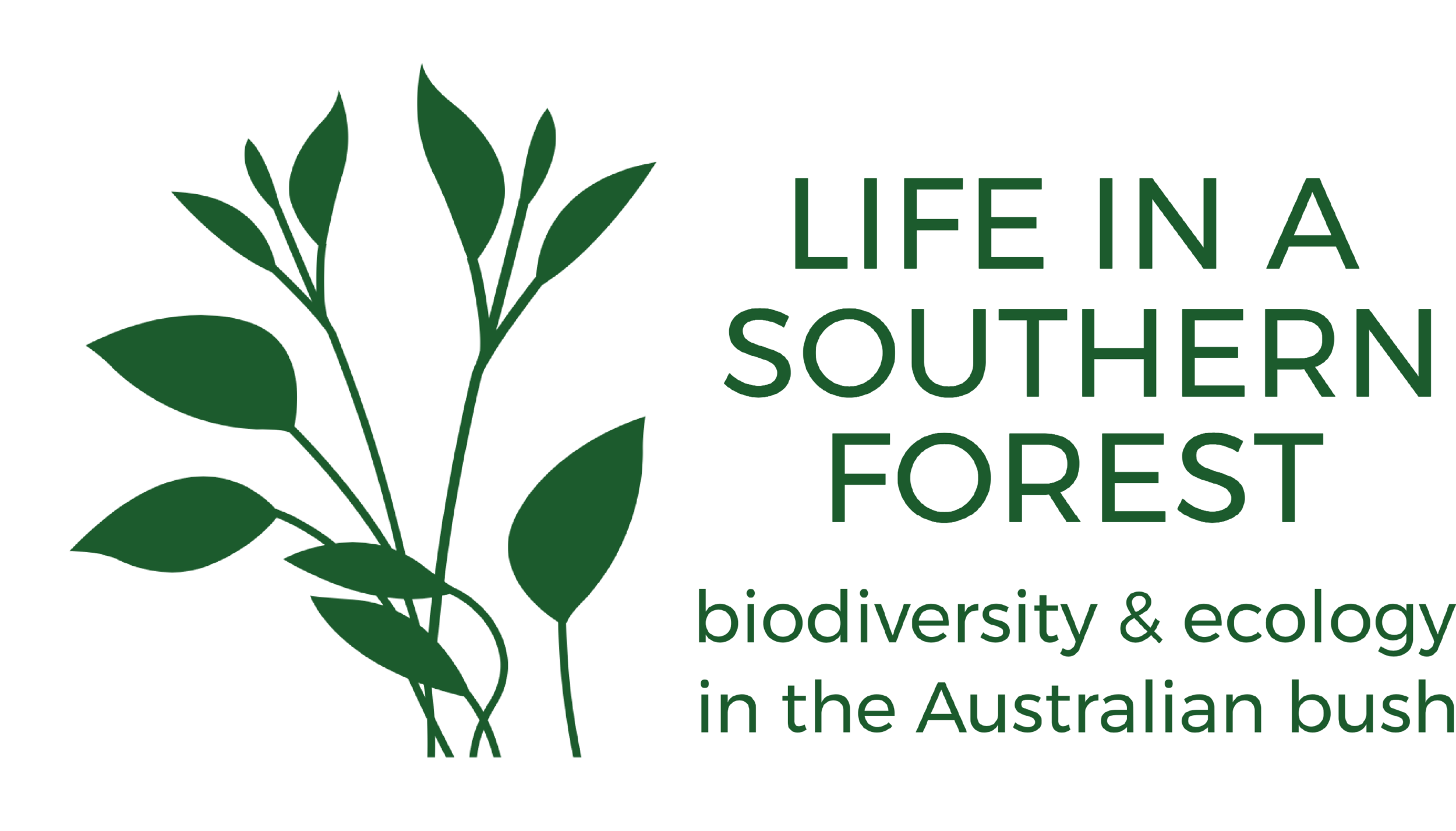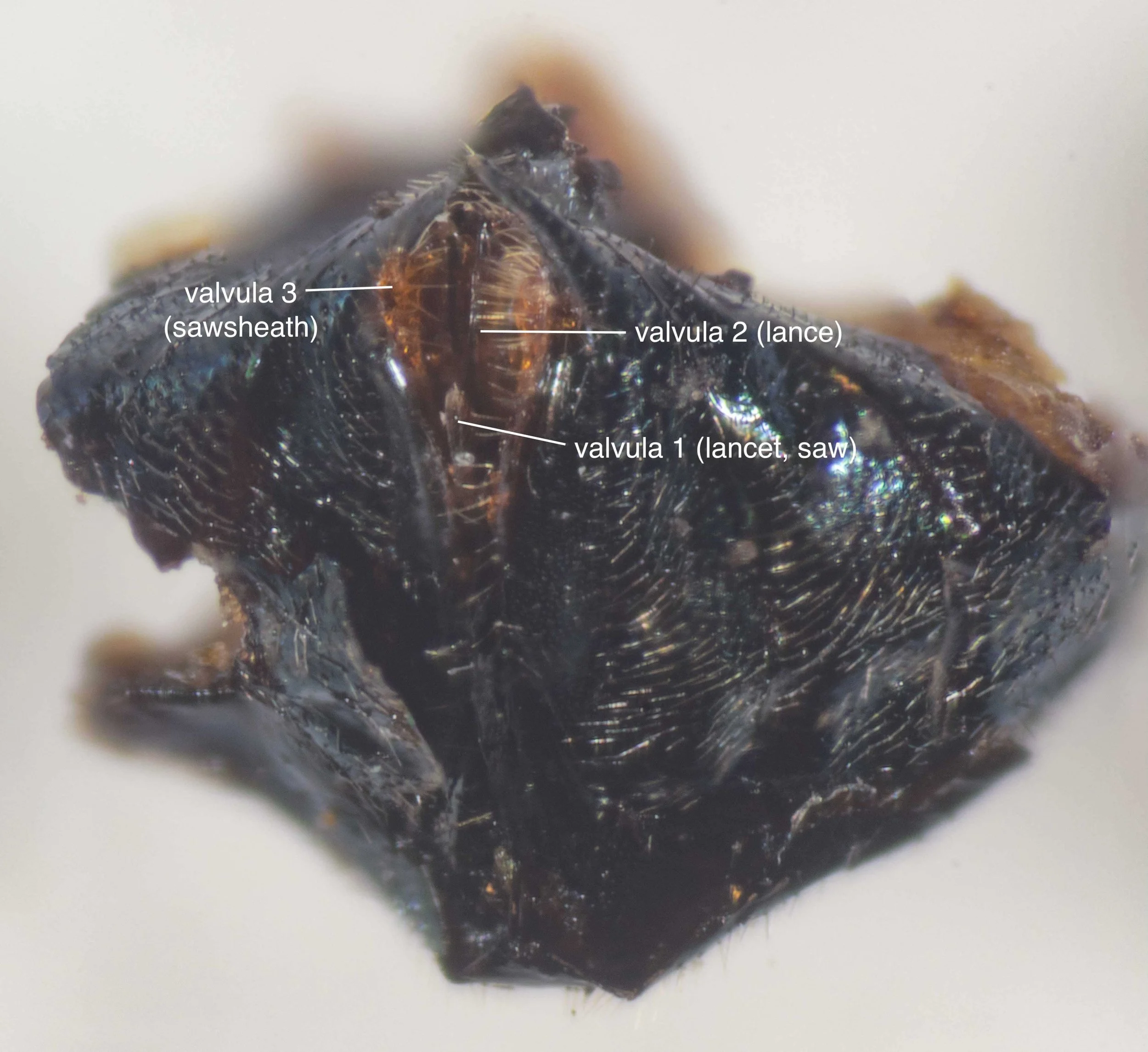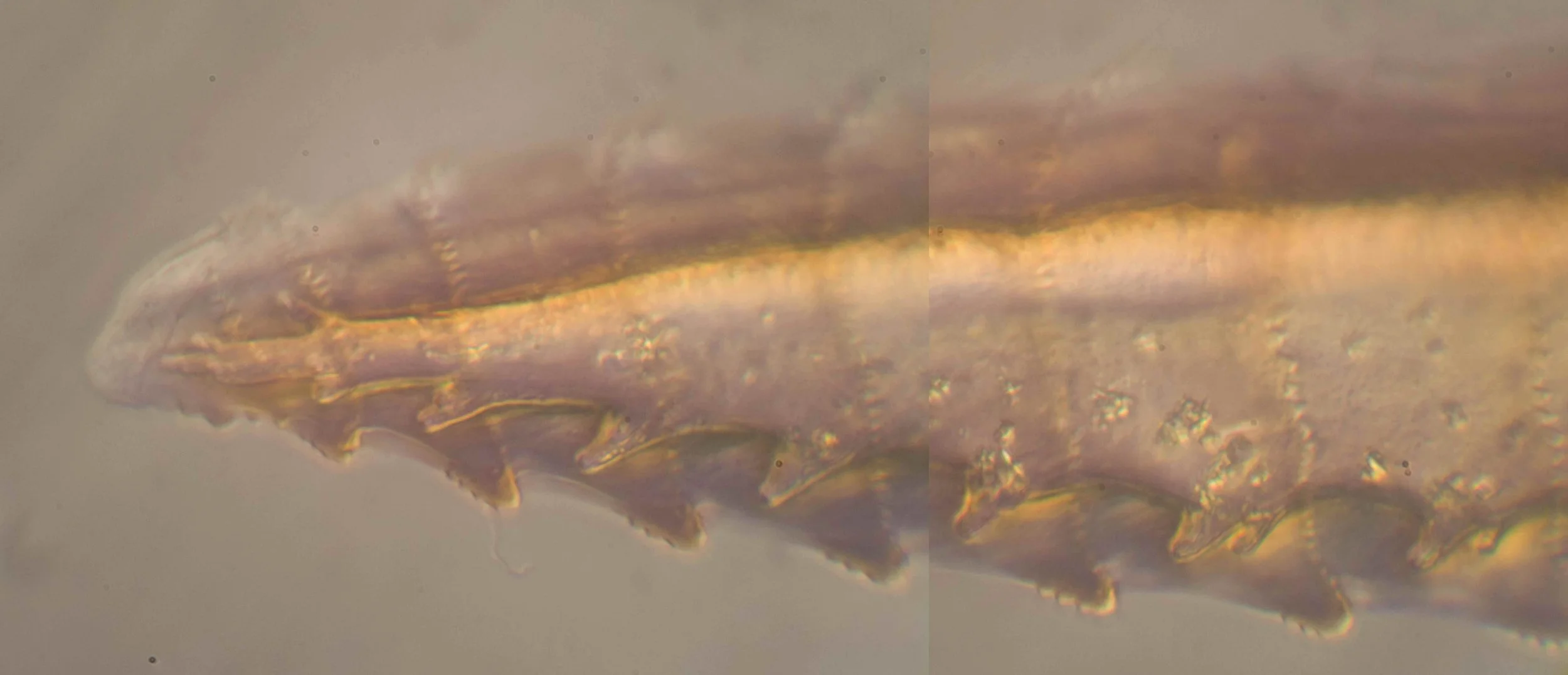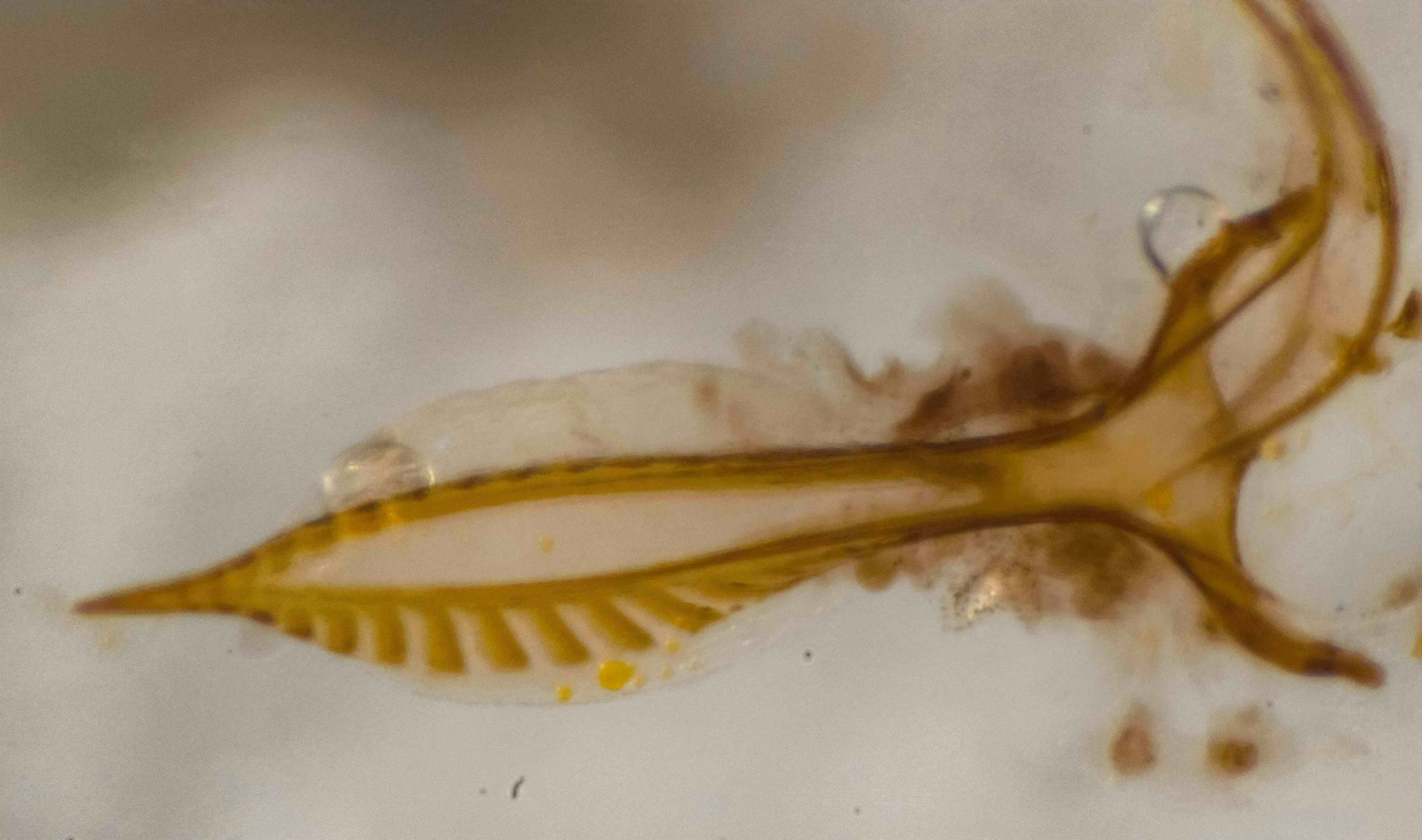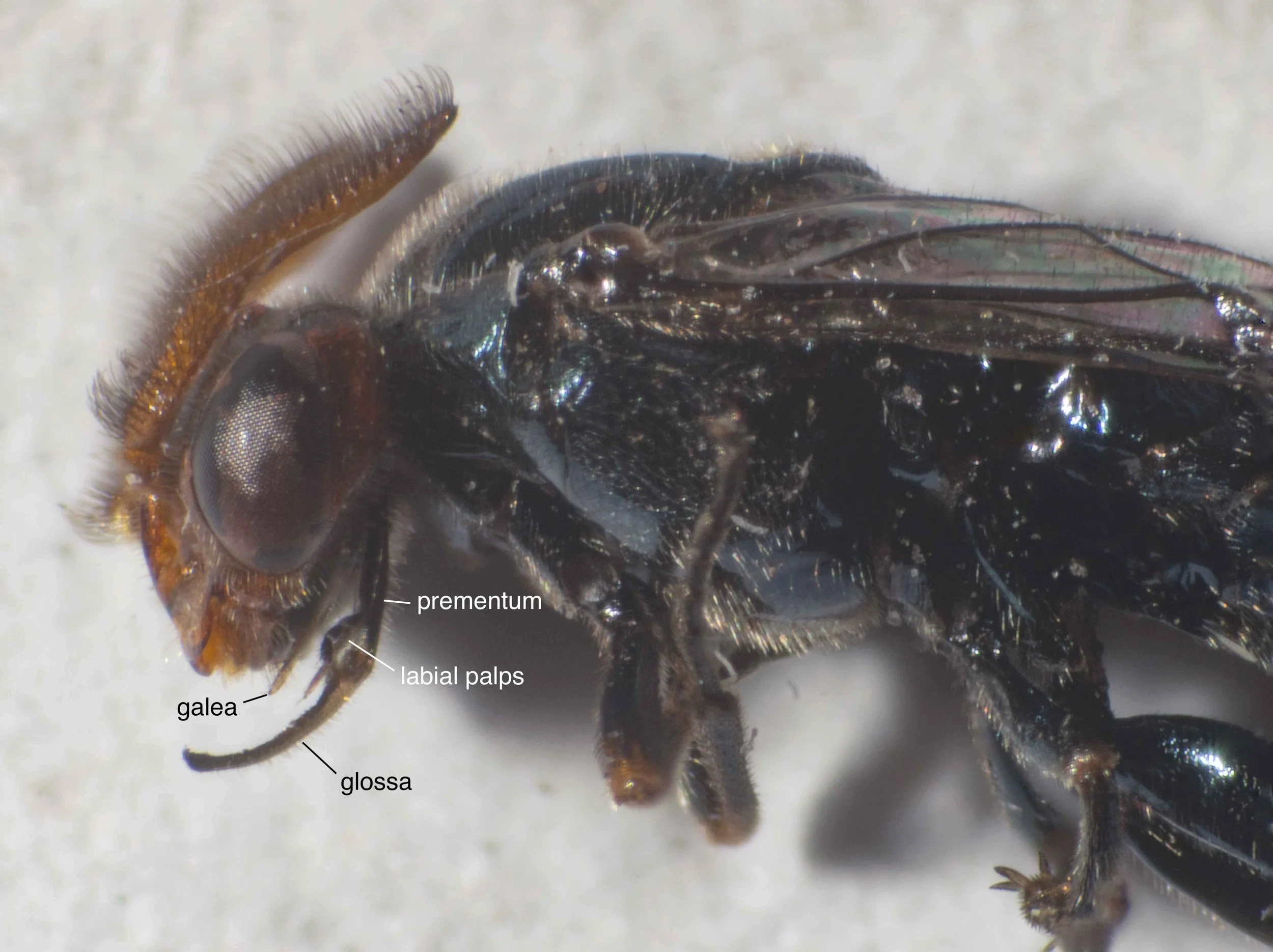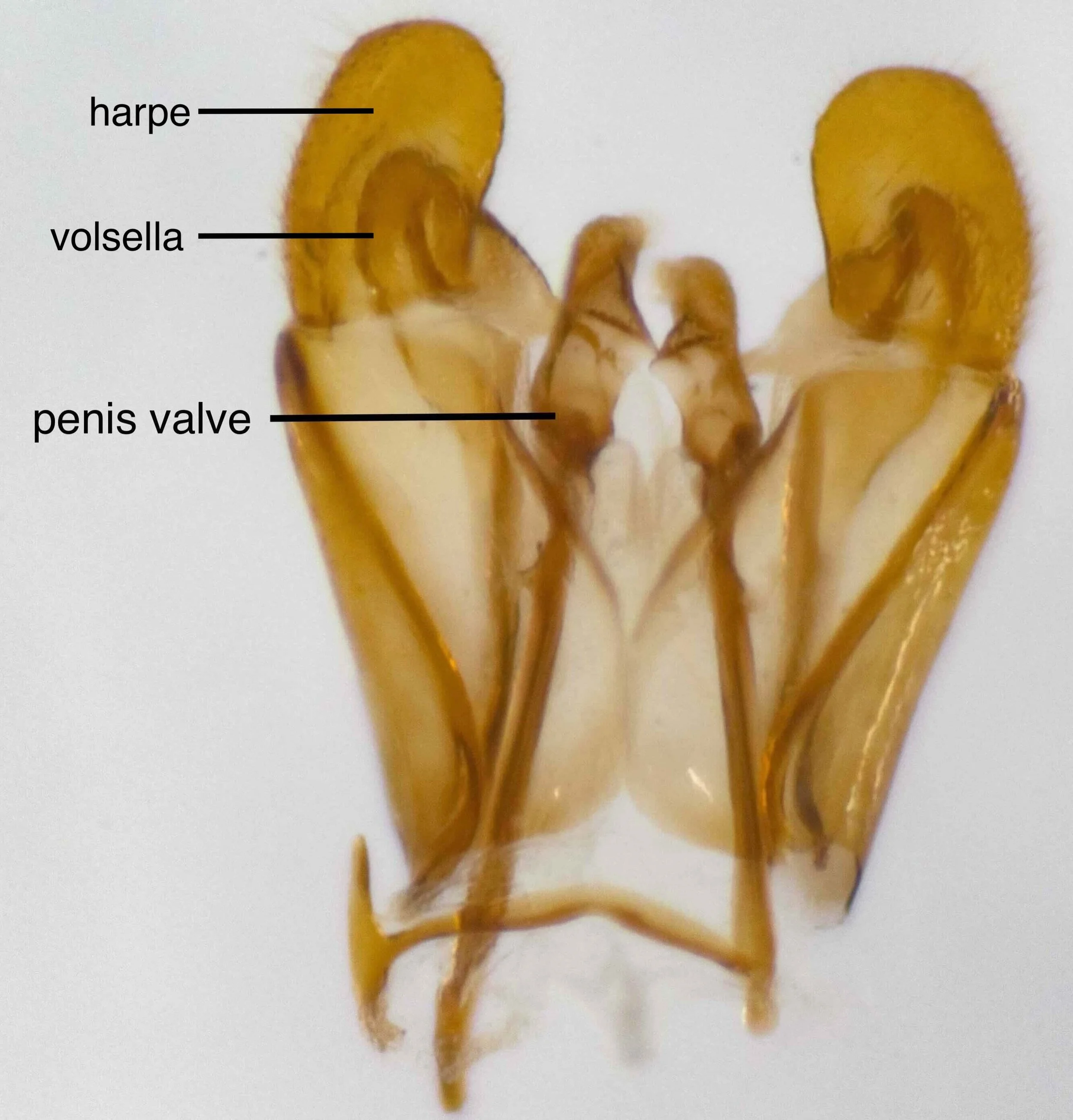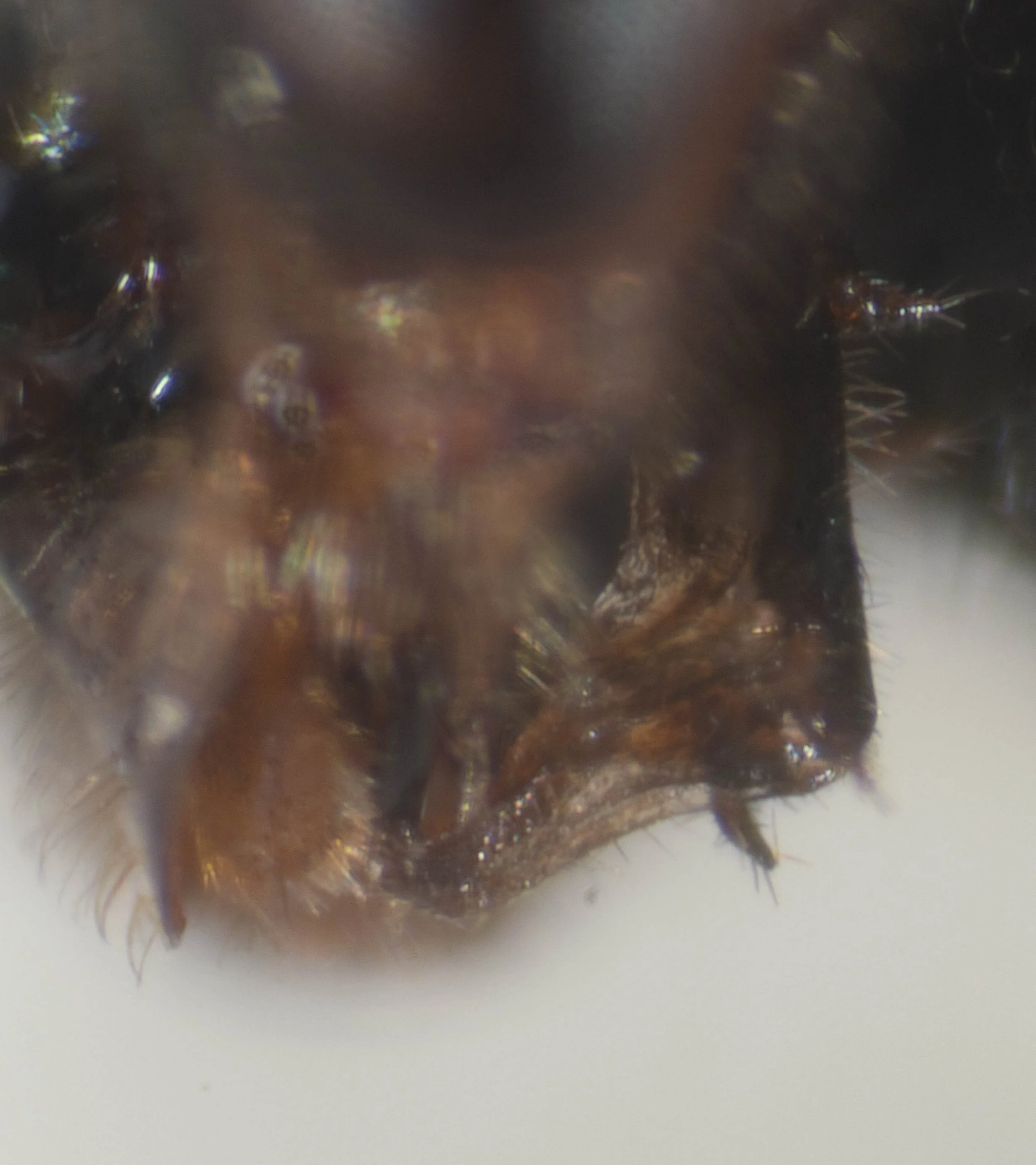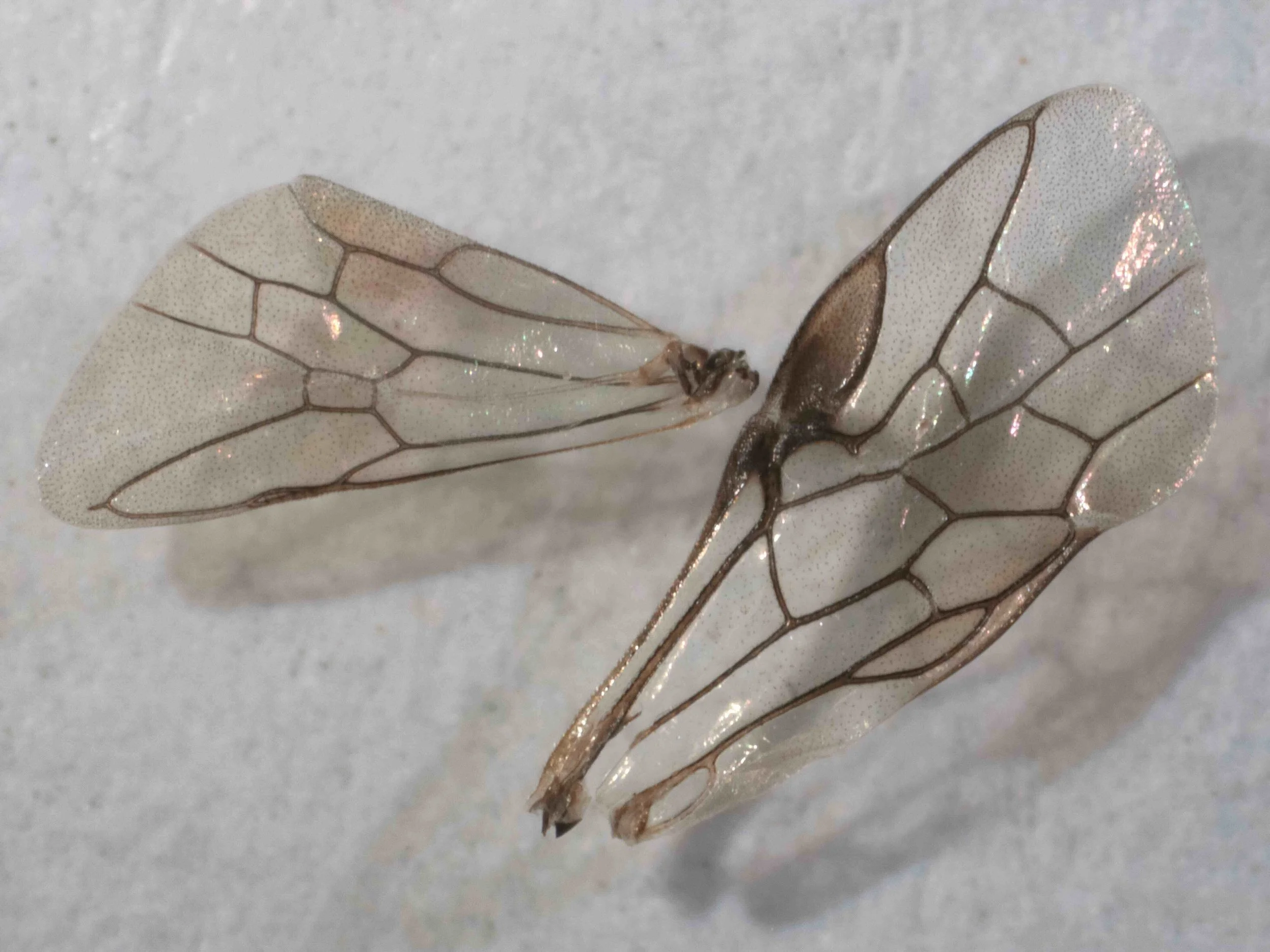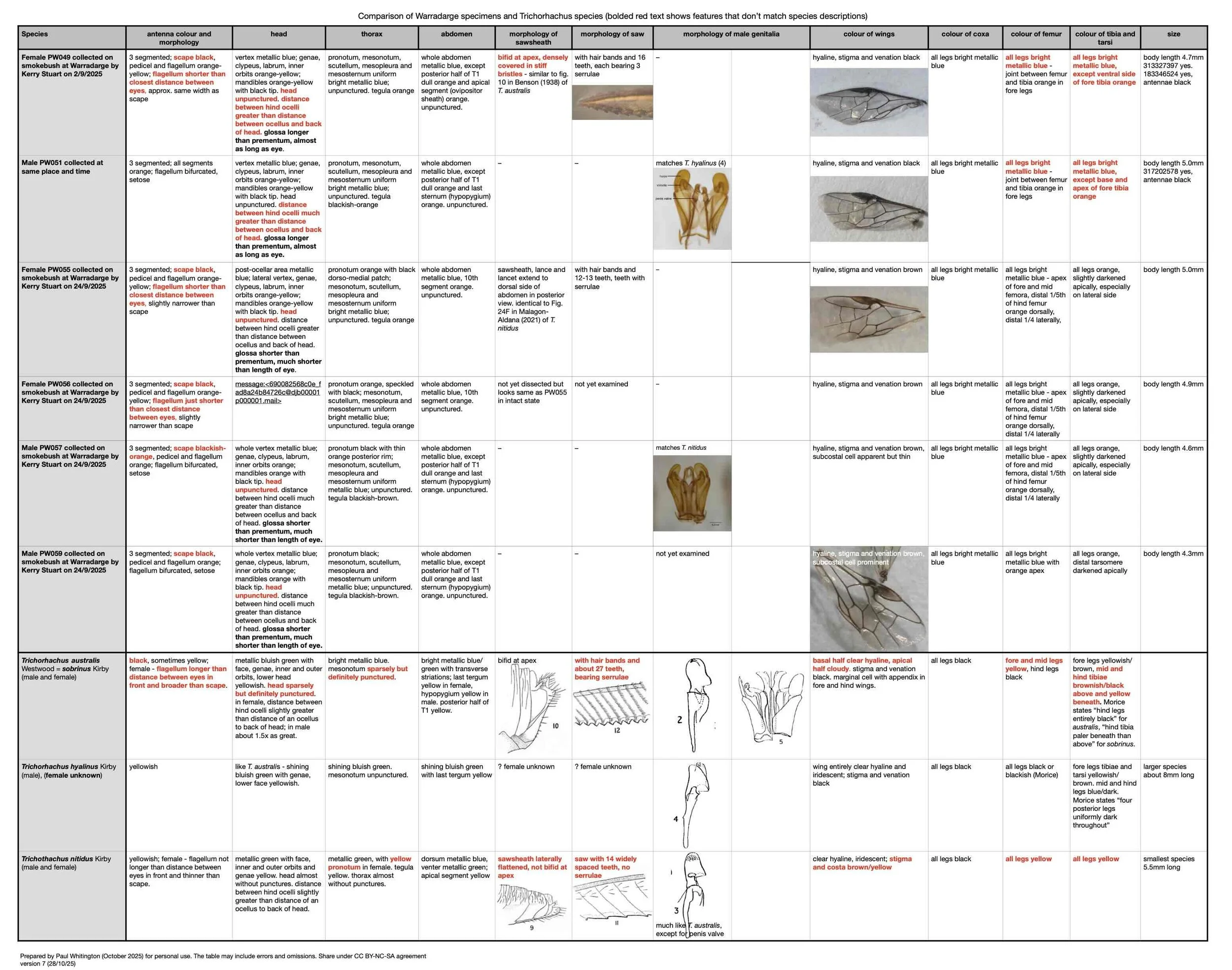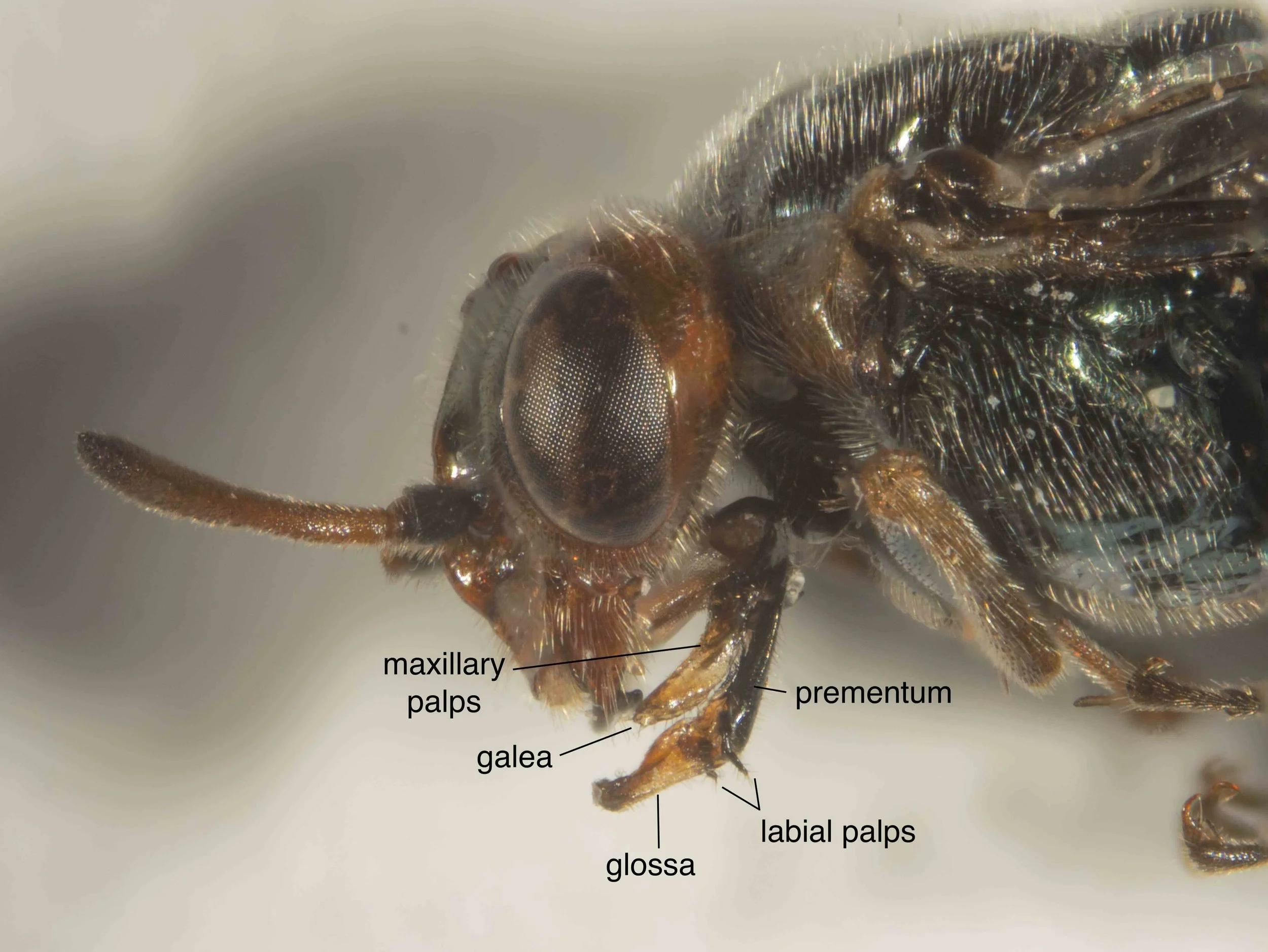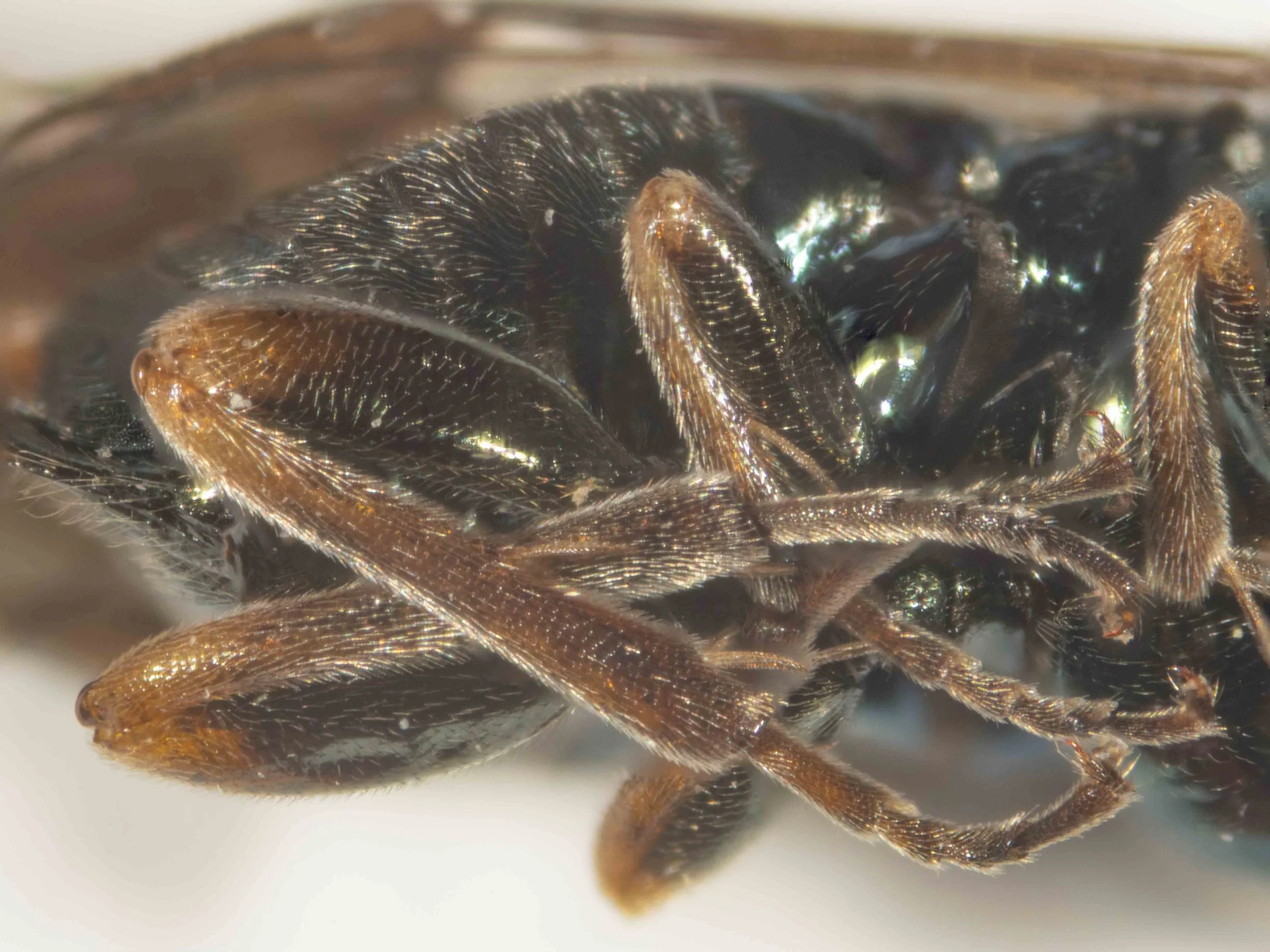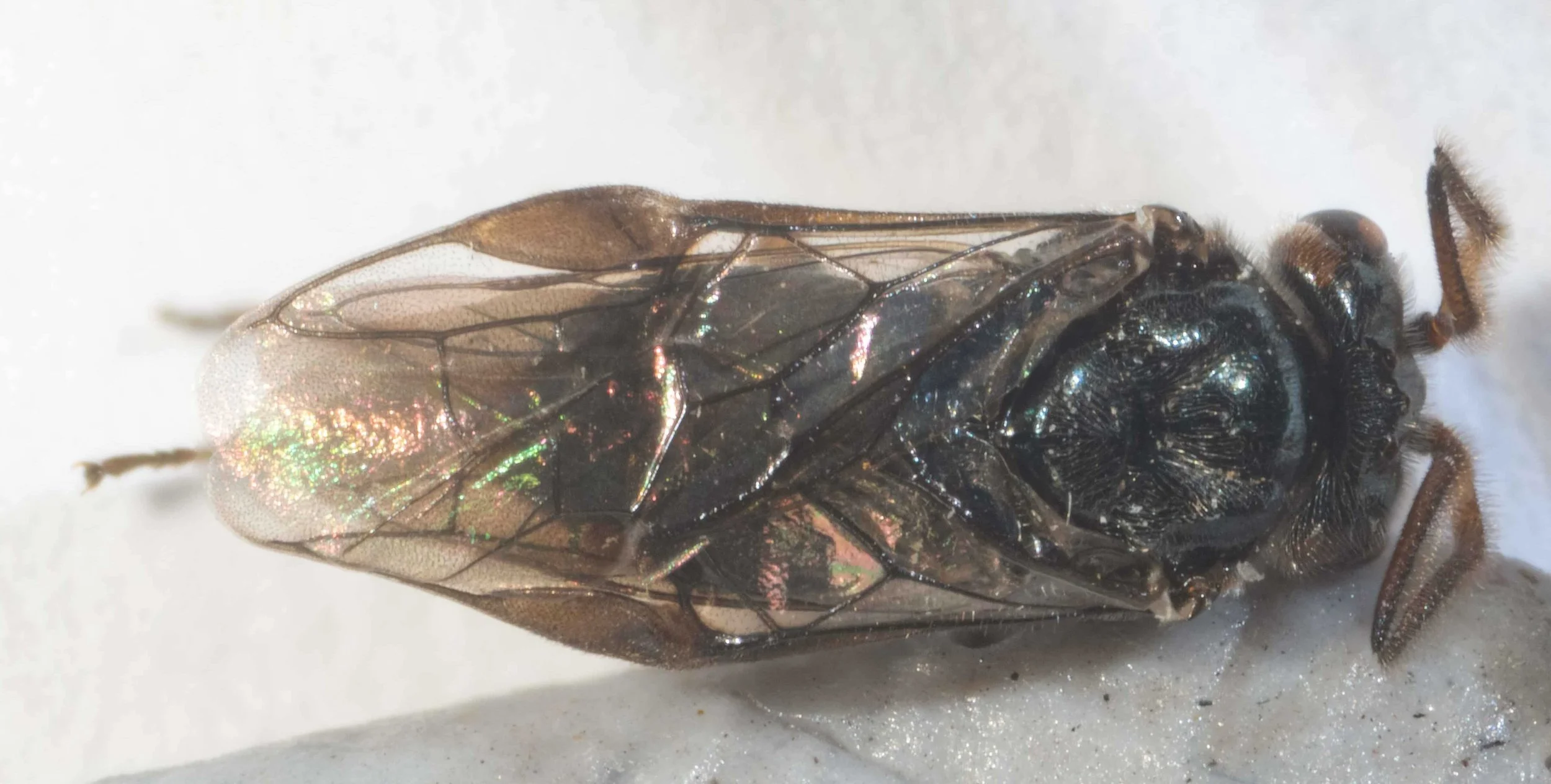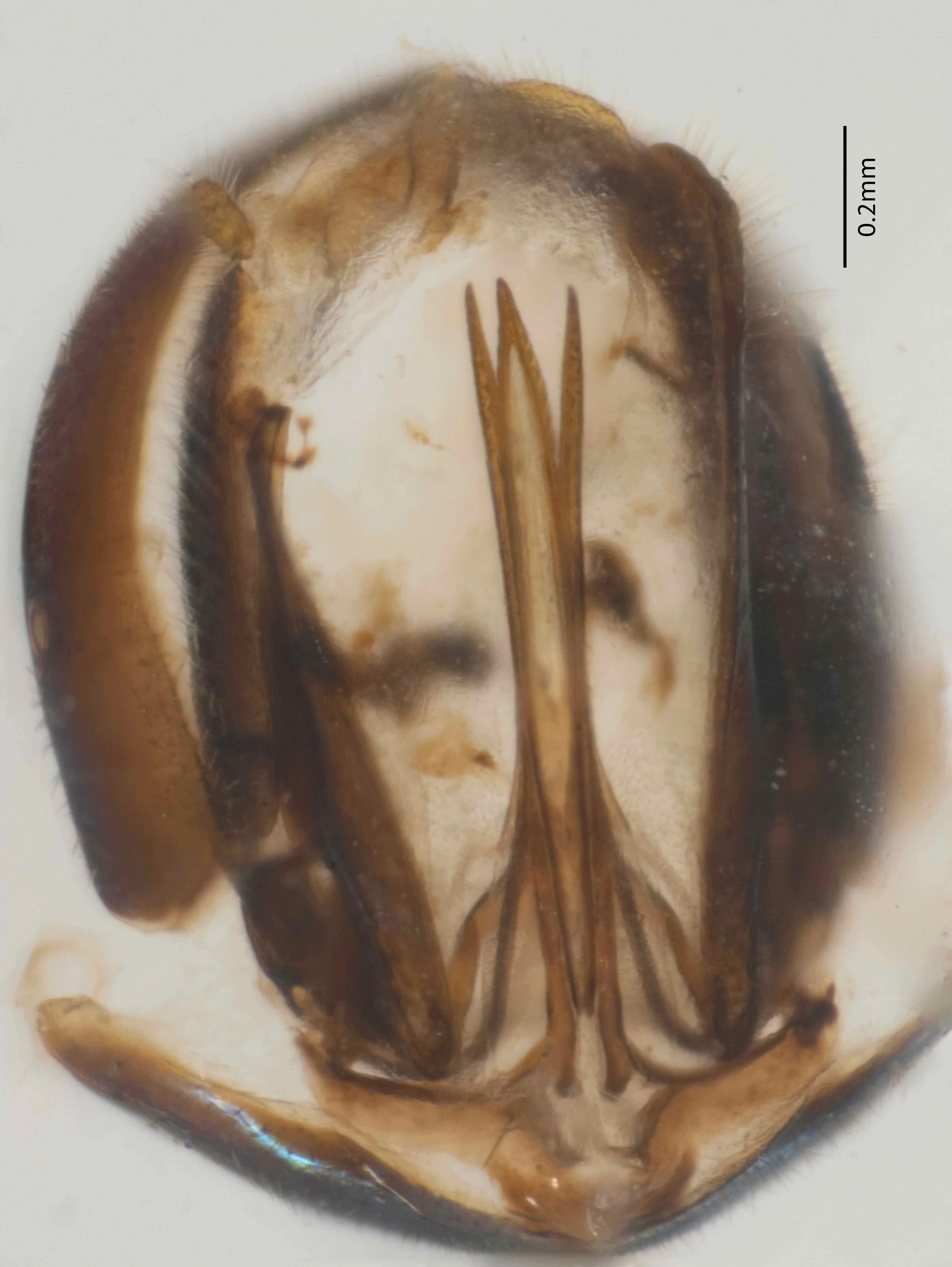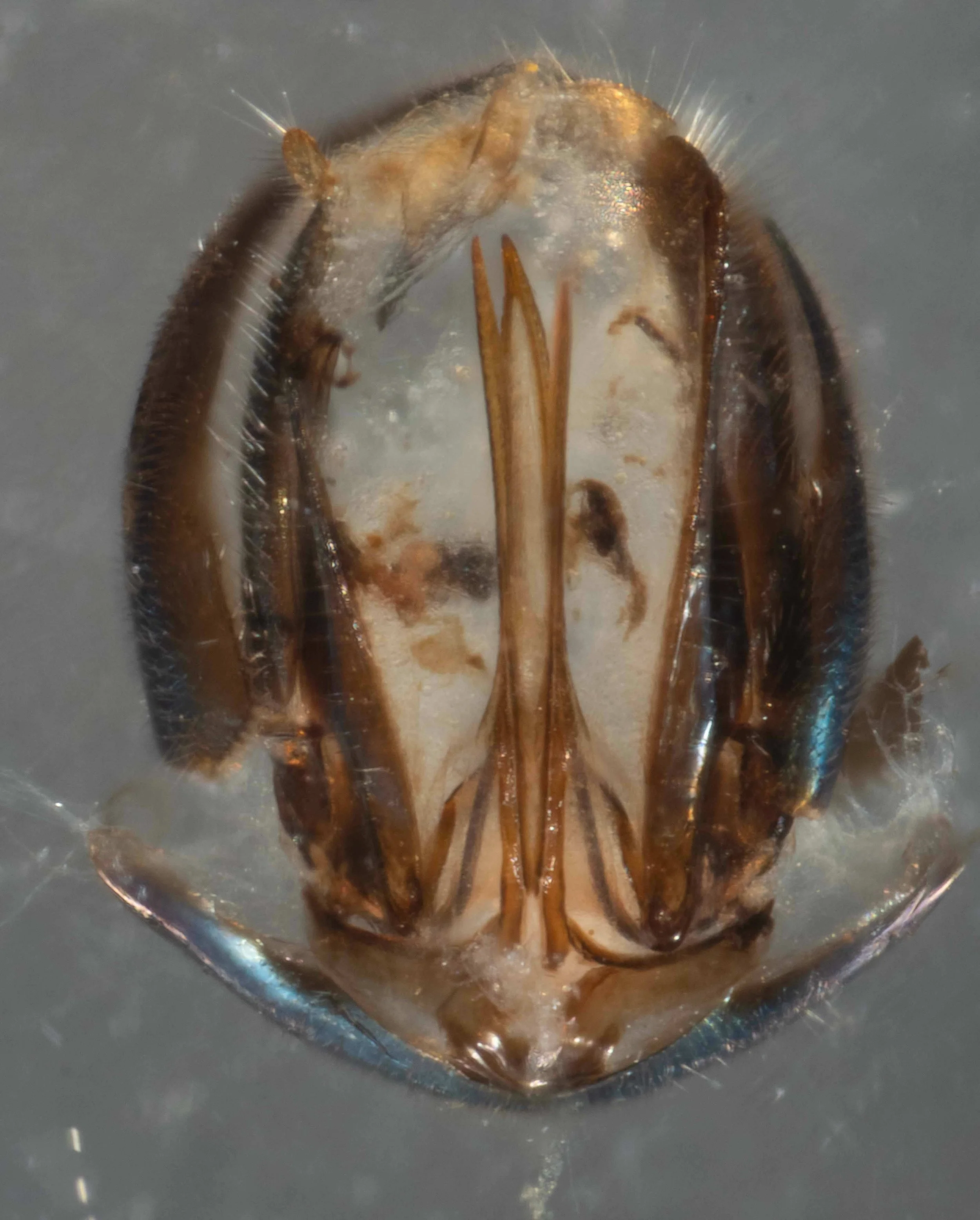
Workbook
Observations on male and female of Trichorhachus spp. received from Kerry Stuart.
Specimens collected in September 2025 at Warradarge, WA.
Note: These Warradarge observations are summarised in a matrix at the end of this section, with a comparison to published descriptions of the 3 Trichorhachus species.
Female #PW049 collected on 2nd September
body length 4.7mm
antennae; 3 segmented, simple
whole thorax, abdomen bright metallic blue
all segments of all legs bright metallic blue laterally and dorsally, except joints between femora and tibiae orange
hind basitarsus longer than next 2 tarsal segments together
genae and face yellow-orange
tongue longer than head, dorsal side blackish
lateral side of head, thorax and abdomen unpunctured
tegula yellow
clypeus, labrum, inner orbits, orange
antennal flagellum shorter than closest distance between eyes
face, ventral side of thorax and abdomen unpunctured
ventral side of thorax and abdomen metallic blue, except for orange apical segment of abdomen
ventral and anterior side of all segments of all legs black, except for ventral side of fore tibiae which are orange
ventral side of tongue grey
pre-apical spur on mid and hind tibiae
antenna; scape black, pedicel and flagellum orange; flagellum single segment, approx. same thickness as scape
mandibles yellow with black tip
labrum and clypeus yellow
inner orbits and genae yellow
glossa (tongue) grey ventrally, black dorsally; almost as long as eye
pronotum, mesonotum and scutellum bright metallic blue, unpunctured
distance between hind ocelli greater than distance between an ocellus and back of head
antennal flagellum about same thickness as scape, shorter than distance between eyes
vertex black, genae orange
prosternum and mesosternum bright metallic blue, without punctures
genae, mandibles, labrum orange
abdomen viewed ventrally
abdomen shining with coarse transverse wrinkles
apical segment of abdomen yellow-orange
abdomen viewed dorsally after removal of wings
all terga bright metallic blue, except posterior tergum 1 pale orange, unpunctured
apical abdominal segment with ovipositor sheath viewed dorsally
lateral view of rear of abdomen, showing ovipositor sheath (third valvula) and protruding tip of saw (lancet or first valvula)
posterior view of end of abdomen showing ovipositor structures
apical tip of ovipositor sheath (third valvula) after removal from body, densely covered in stiff bristles
saw (lancet or first valvula) dissected from female - with hair bands and 16 teeth, each bearing smaller denticulations (serrulae).
different number of teeth to T. australis and different to T. nitidus in possessing serrulae
enlarged view of end of saw (lancet or first valvula) showing teeth 1-6, each with 3 small serrulae (denticulations)
Malagon-Aldana et al (2021) state that in the Trichorhachus sp. ovipositor examined (Fig. 27A,B) serrulae were absent.
distal 2/3rd of saw (lancet)
saw is similar to T. australis but has fewer teeth (16 vs. 27)
lance (second valvula) dissected from body
lance (second valvula) dissected from body
forewing RHS
hyaline; stigma and venation black; basal vein joins subcosta at a distance from the cubitus almost as great as the length of the 1st transverse cubital vein
hind wing RHS
hyaline, stigma and venation black
forewing LHS
hyaline; stigma and venation black; basal vein joins subcosta at a distance from the cubitus almost as great as the length of the 1st transverse cubital vein
hind leg - all segments black
mid leg - all segments black, tibia with preapical spur
fore leg - tibia orange on ventral surface, all other segments black
fore leg - tibia orange on ventral surface, all other segments black
Male #PW051 collected on 2nd September
body length 5.0mm
antennae orange, 3 segmented, flagellum bifurcated, setose
whole thorax, abdomen bright metallic blue
all segments of all legs bright metallic blue laterally and dorsally, except joints between femora and tibiae orange
hind basitarsus longer than next 2 tarsal segments together
parts of proboscis shown:
- glossa (tongue), labial palps and prementum parts of labium; glossa longer than prementum, almost same length as eye
- galea, most distal part of maxilla
antennae; 3 segmented, all segments orange; flagellum bifurcated, setose
clypeus, labrum, mandibles and genae orange
glossa (tongue), labial palps and prementum parts of labium; glossa longer than prementum, approx. same length as eye
pronotum, mesonotum and mesopleura bright metallic blue, unpunctured
antennae: 3 segmented, flagellum bifurcated, setose
distance between hind ocelli much greater than distance between ocellus and back of head
vertex black, genae orange
pronotum, mesonotum and scutellum bright metallic blue, unpunctured
forewings hyaline, stigma and venation black; basal vein joins subcosta at a distance from the cubitus almost as great as the length of the 1st transverse cubital vein
labrum, inner orbits, orange
face, ventral side of thorax and abdomen unpunctured
ventral side of thorax and abdomen metallic blue, except for orange apical segment (hypopygium) of abdomen
ventral and anterior side of all segments of all legs black
pre-apical spur on mid and hind tibiae
after removal of mid and hind legs:
labrum, mandibles, all 3 segments of antennae orange
ventral side of thorax and abdomen unpunctured and metallic blue, except for orange apical segment (hypopygium) of abdomen
all segments of fore legs shiny metallic blue, except basal ¼ of tibiae orange
abdomen viewed ventrally:
bright metallic blue, unpunctured
apical segment (hypopygium) orange
dorsal thorax and abdomen after removal of wings and legs
pronotum, mesonotum, scutellum bright metallic blue; unpunctured
abdomen, all terga bright metallic blue except posterior half tergum 1 pale yellow; with coarse transverse wrinkles but unpunctured
rear of abdomen, dorsal view
all terga shining metallic blue; without punctures
orange harpe, tongue-shaped cusps used to grip base of female genitalia during copulation, protruding from rear of body
genitalia dissected from male - close match to drawing of penis valve of T. hyalinus (Fig. 4) in Benson (1938)
genitalia dissected from male - compare to following figures from Benson (1938)
genitalia dissected from male - compare to following figures from Benson (1938)
hind legs: right leg above, outer surface (coxa missing); left leg below, inner surface, with detached coxa
all segments shiny metallic blue, tibia with a preapical spur
hind basitarsus longer than next 2 tarsal segments
hind legs: right leg on left, inner surface (coxa missing); left leg on right, outer surface, with detached coxa
all segments shiny metallic blue, tibia with a preapical spur
hind basitarsus longer than next 2 tarsal segments together
mid legs: left, inner side of right leg (missing coxa and last 3 tarsomeres); right, lateral side of left leg (missing coxa)
all segments shiny metallic blue, tibia with a preapical spur
mid legs: top, lateral side of right leg (missing last 3 tarsomeres); below, inner side of left leg
all segments shiny metallic blue, tibia with a preapical spur
right foreleg (missing trochanter and coxa) - all segments black, except base and apex of tibia orange
right foreleg (missing coxa) - all segments black, except base and apex of tibia orange
left forewing: hyaline, stigma and venation black; basal vein joins subcosta at a distance from the cubitus almost as great as the length of the 1st transverse cubital vein
left hindwing; hyaline, black veins
Female #PW055 collected on 24th September
body length 5.0mm
antenna; 3 segmented, simple; scape black, pedicel and flagellum orange
antennal flagellum shorter than closest distance between eyes
flagellum slightly narrower than scape
ventral side of thorax and abdomen bright metallic blue, pronotum orange
genae, labrum, mandibles orange (latter with black tips)
legs: all coxae and femora black; apex of fore and mid femora, apical 1/5th hind femora orange; all tibiae and tarsi orange with apices slightly infuscated
genae, lateral vertex orange
lateral side of thorax, mesonotum, scutellum and abdomen metallic blue; tegula blackish-orange
legs: all coxa and femora black; except apical ¼ of femur orange laterally; all tibiae and tarsi orange, slightly infuscated in apical half laterally
genae and vertex orange, except post-ocellar area black
mesoscutum, scutellum bright metallic blue, unpunctured
stigma brown, venation dark brown, subcostal cell clearly evident
glossa shorter than prementum; much shorter than length of eye
antennal flagellum slightly narrower than scape at greatest width
genae, inner orbits, clypeus, labrum orange
pronotum orange with black dorsal patch
tegula brownish-orange
mesopleura, mesoscutum and scutellum bright metallic blue, unpunctured
wings hyaline, venation brown
abdomen metallic blue laterally
venation brown, subcosta cell prominent
forewing hyaline, stigma blackish-brown, venation brown
abdomen shiny metallic blue; sawsheath black with brown apex
glossa (orange) shorter than prementum (black), much shorter than eye length
galea grey/orange
glossa (orange) shorter than prementum (black), much shorter than eye length
galea grey/orange
vertex black; inner orbits, clypeus, labrum, mandibles orange
prominent frontal carina
inner orbits, clypeus, labrum, mandibles orange (latter with black tips)
prominent frontal carina
post-ocellar area black, vertex more laterally orange; unpunctured
distance between posterior ocelli greater than distance to back of head
pronotum orange with black patch on dorso-medial side
pronotum orange with medial black patch
mesonotum, scutellum bright metallic blue, unpunctured
tegulae orange
pronotum orange with black dorso-medial patch
vertex laterally, genae and inner orbit orange
antennal flagellum slightly narrower than scape
apex of abdomen viewed dorso-laterally
shiny metallic blue, unpunctured
cerci, 10th abdominal segment orange
sawsheath (3rd valvula) black, laterally flattened
abdomen viewed from rear after removal from female and treatment overnight with KOH
identical to photograph of T. nitidus genitalia in Malagon-Aldana et al (2021), Fig. 24F
sawsheath (3rd valvula) separated from female genitalia
sawsheath (3rd valvula) separated from female genitalia
dissection of female genitalia
one side of saw (1st valvula, lancet) above
other side of saw attached to lance (2nd valvula) below
saw dissected from female genitalia
12-13 teeth
saw teeth with serrulae
tip of saw (lancet) showing last 4 teeth, which are serrulated
forewing
hyaline: costa, stigma and veins brown
prominent precostal cell
Female #PW056 collected on 24th September
body length 4.9mm
antenna: 3 segmented, simple; scape black, pedicel and flagellum orange
antennal flagellum just shorter than distance between eyes
flagellum slightly narrower than scape
ventral side of thorax and abdomen bright metallic blue, pronotum orange
genae, labrum, mandibles orange (latter with black tips)
legs: all coxae and femora black with apical 1/5th - ¼ of femora orange; all tibiae and tarsi orange with some tarsal segments darkened in some legs
genae, lateral vertex orange
lateral side of thorax, mesonotum, scutellum and abdomen metallic blue; tegula orange; pronotum orange, mottled with black
legs; all coxae and femora black; except apical ¼ of hind femur orange laterally; all tibiae and tarsi orange, some tarsal segments of some legs darkened apically
genae and vertex orange, except post-ocellar area black
mesoscutum, scutellum bright metallic blue, unpunctured
stigma brown, venation dark brown
subcostal cell clearly evident
genae, inner orbits, vertex orange; post-ocellar area black
glossa shorter than prementum; much shorter than length of eye; labial palps black
pronotum orange, speckled with black
tegula orange
mesonotum, scutellum, pleurae shiny metallic blue. unpunctured
wings hyaline, brown venation, subcostal cell clearly evident
detail of mouthparts
glossa (orange) shorter than prementum (black), labial palps black, 4-segmented
glossa shorter than prementum; much shorter than length of eye
genae, inner orbits, clypeus, labrum, mandibles orange (latter with black tips)
tegula orange
pronotum orange, speckled with black
mesopleura, mesoscutum bright metallic blue, unpunctured
wings hyaline, brown venation, subcostal cell clearly evident
mesopleura, metapleura bright metallic blue, unpunctured
legs: coxae and femora of fore and mid legs black; apical tip of femora orange; tibiae and tarsi orange
abdomen shiny metallic blue
10th abdominal segment orange; cerci orange
sawsheath black with brown apex
wings hyaline, brown venation, subcostal cell clearly evident
forewings hyaline
subcostal cell clearly evident
costa, stigma and venation brown
genae, inner orbits, clypeus, labrum, mandibles orange (latter with black tips)
glossa orange, prementum black, maxillary palps black
antennal flagellum slightly longer than closest distance between eyes
flagellum slightly narrower than scape
inner orbits, genae, clypeus, labrum, mandibles orange (latter with black tips)
glossa orange
antennal flagellum slightly narrower than scape at thickest point
vertex black with region lateral to post-ocellar area orange
distance between hind ocelli greater than distance between an ocellus and back of head
mesoscutum and scutellum shiny metallic blue, unpunctured
pronotum orange, speckled with black
ventral view of genitalia
sawsheath black, laterally flattened
cerci orange
Male #PW057 collected on 24th September
body length 4.6mm
antennae 3 segmented, flagellum bifurcated, setose; scape blackish-orange, pedicel orange; flagellum orange
genae, inner orbits orange
lateral side of thorax, mesonotum, scutellum and abdomen black; tegula blackish-orange; pronotum black with thin posterior orange rim
legs: all coxae and femora black, except apex of hind femur orange; all tibiae and tarsi orange, apex of hind tibia blackish
distance between hind ocelli much greater than distance between ocellus and back of head
vertex black, genae orange
mesoscutum, scutellum bright metallic blue; unpunctured
forewings hyaline, stigma, costa and venation dark brown; subcostal cell barely evident
scape black, pedicel blackish-orange; flagellum orange
clypeus, labrum, inner orbits, mandibles (except for black tips) orange
ventral side of thorax and abdomen metallic blue, except for orange apical segment (hypopygium) of abdomen; unpunctured
legs: coxae, ventral side of all legs black; femora, ventral side of all legs black with apices orange; all tibiae and tarsi orange, apex of hind tibiae and some tarsal segments somewhat infuscated
distance between hind ocelli much greater than distance from an ocellus to back of head
vertex solid black, genae orange
pronotum black with thin orange posterior rim
mesoscutum, scutellum bright metallic blue, unpunctured
tegula blackish-brown
clypeus orange with thin black rim, labrum orange, mandibles orange with black tips, inner orbits orange
glossa pale orange with black base, prementum black, labial palps with orange tips
scape blackish-brown, pedicel brown
clypeus orange with prominent midline ridge; labrum, inner orbits orange; mandibles orange with black tips
fore coxae black, fore femora black with apical 1/5th orange on ventral side, tibiae and tarsi orange
ventral view of abdomen
all segments of venter bright metallic blue, except for orange apical segment (hypopygium); orange harpe
dorsal view after removal of legs and posterior half of abdomen
all terga bright metallic blue, except posterior half of tergum 1 pale yellow; unpunctured
forewings hyaline; costa and venation brown; subcostal cell thin but present
distal half of forewing; hyaline, stigma, costa and venation brown
hind leg; costa black, femur black with distal 1/5th orange, tibia and tarsi orange with apex of tibia black
foreleg; femur black with apical tip orange; tibia and tarsi orange with apical tarsomeres blackish
middle leg; femur black with apical tip orange, tibia and tarsi orange with infuscation of tips of tarsal segments
genitalia dissected from PW057 - close similarity to drawing of T. nitidus male genitalia in Fig. 19, D-F Malagon-Aldana et al (2021), see Reference images below.
genitalia dissected from PW057 - close similarity to drawing of T. nitidus male genitalia in Fig. 19, D-F Malagon-Aldana et al (2021), see Reference images below.
genitalia dissected from PW057 - close similarity to drawing of T. nitidus male genitalia in Fig. 19, D-F Malagon-Aldana et al (2021), see Reference images below.
genitalia dissected from PW057 - close similarity to drawing of T. nitidus male genitalia in Fig. 19, D-F Malagon-Aldana et al (2021), see Reference images below.
genitalia dissected from PW057 - close similarity to drawing of T. nitidus male genitalia in Fig. 19, D-F Malagon-Aldana et al (2021), see Reference images below.
Male #PW059 collected on 24th September
body length 4.3mm
antenna 3 segmented, flagellum bifurcated, setose; scape black, pedicel orange, flagellum orange
genae orange
lateral side of thorax, mesonotum, scutellum and abdomen metallic blue; tegula black; pronotum black
legs: all coxae and femora black, with apex of femora orange; all tibiae and tarsi orange, apex of tarsi blackish
body length 4.3mm
scape black, pedicel orange, flagellum orange
clypeus, labrum, inner orbits, genae, mandibles (except for black tips) orange
ventral side of thorax and abdomen metallic blue, except for orange apical abdominal segment (hypopygium); unpunctured
legs: coxa, femur all black, except apex of femur; all tibiae and tarsi orange, apex of tarsomeres somewhat infuscated
mesoscutum, scutellum bright metallic blue, unpunctured
forewings hyaline; stigma, costa brown; venation dark brown
scape blackish-brown, pedicel brown
clypeus orange with thin black rim, labrum orange, mandibles orange with black tips
genae orange, inner orbits orange, frons black
fore coxae black, fore femora black with apical 1/5th orange on ventral side, tibiae and tarsi orange
glossa orange, speckled black, labial palps with orange tips
pronotum, mesopleura, mesosternum black
fore and mid coxae and femora black, apical tip of femora orange, tibiae and tarsi orange
glossa pale orange, speckled black, labial palps orange and black, 4-segmented; prementum black, longer than glossa
galea greyish-pale orange, maxillary palps black
scape black, pedicel and flagellum orange
clypeus, labrum, inner orbits, genae orange
pronotum, mesoscutum, mesopleura shiny metallic blue; unpunctured
tegula blackish-orange
side view of proboscis
glossa pale grey, speckled black, tip of labial palps brown; prementum black
galea greyish orange, maxillary palps blackish-orange
tegula blackish-brown
wings hyaline, subcostal cell prominent, costa, venation brown
apical segment of abdomen (hypopygium) orange
orange-brown cerci
abdomen metallic blue laterally
stigma, venation brown, subcostal cell prominent
hind leg: coxa, femur metallic blue, apical tip femur yellow
ventral view abdomen
all segments of venter bright metallic view, except orange apical segment (hypopygium); protruding harpe orange
distance between hind ocelli much greater than from ocellus to back of head
vertex solid black, genae orange
pronotum solid black
mesoscutum, scutellum bright metallic blue, unpunctured
forewings hyaline: costa, stigma, brown; subcostal cell prominent; venation dark brown
forewing hyaline; costa, stigma and venation dark brown
dorsal view after removal of left wings
all terga bright metallic blue, except posterior half of tergum 1 pale yellow
LH fore and hind wings removed; hyaline, costa, stigma, venation dark brown; subapical cell prominent
The matrix below (click to download a 397KB pdf version) summarises the observations of male and female specimens from Warradarge and compares them to published descriptions of the 3 known Trichorhachus species.
Conclusions:
Warradarge male PW051 collected on 2/9/25 is a good match to published descriptions of T. hyalinus males. Given the similarities between Warradarge male PW051 and female PW049 - in particular, the morphology of the proboscis - it is likely that the Warradarge female PW049 is the undescribed female of T. hyalinus.
It differs from female T. australis in several other characters: antennal flagellum shorter vs. longer than distance between eyes; body unpunctured (vs. sparsely but definitely punctured); distance between hind ocelli greater (vs. slightly greater) than to back of head; saw with 16 (vs. 27) serrulated teeth; wings hyaline (vs. half hyaline, half cloudy).
It differs from female T. nitidus in the following characters: pronotum bright metallic blue (vs. yellow); sawsheath bifid at apex (vs. not bifid and laterally flattened); saw with 16 variably spaced, serrulated teeth (vs. 14 widely spaced, non-serrulated teeth); stigma and costa black (vs. brown); femora black (vs. yellow).
Warradarge female PW055 collected on 24/9/2025 is an excellent match in both somatic and genitalia morphology to published descriptions of T. nitidus. In particular the sawsheath, lance and lancet morphology viewed posteriorly is identical to the photo of T. nitidus genitalia in Fig. 24F in Malagon-Aldana et al (2021). Second female PW056 collected at same time as PW055 is almost identical, although genitalia have not yet been dissected for close examination.
Warradarge male PW057 collected at same time as females PW055, PW056 has a very similar morphology and body colouration to those females, in particular morphology of proboscis, colour of pronotum and legs. Those features separate it from the male PW051, which matches the description of T. hyalinus.
Specimens collected in September 2025 at Creyk Park, WA.
Note: These Creyk Park observations are summarised in a matrix at the end of this section, in which a comparison is drawn with published descriptions of the 3 Trichorhachus species.
Female #PW052 collected on 9th September
body length 5.0mm
antennae: 3 segmented, simple; scape black, pedicel and flagellum orange
antennal flagellum longer than closest distance between eyes
flagellum slightly narrower than scape
ventral side of thorax and abdomen bright metallic blue
genae, labrum, mandibles orange (latter with black tips)
legs: all coxae and femora black, all tibiae and tarsi orange-blackish
genae orange, vertex black
proboscis shorter than head, galea relatively short
lateral side of thorax, mesonotum, scutellum and abdomen metallic blue; tegula blackish-orange
legs: all coxae and femora black, except hind femora black basal half, orange apical half dorsally; all tibiae and tarsi orange
antenna black scape, orange pedicel and flagellum (with apex blackened), thinner than scape
genae orange, black vertex
pronotum black medially, orange laterally
mesoscutum, scutellum bright metallic blue, unpunctured
stigma brown, venation dark brown
parts of proboscis shown:
- glossa (tongue), labial palps and prementum parts of labium; glossa shorter than prementum, much shorter than length of eye
- galea and maxillary palps parts of maxilla
antennal flagellum slightly narrower than scape at greatest width
parts of proboscis shown:
- glossa (tongue), labial palps and prementum parts of labium; glossa shorter than prementum, much shorter than eye length
- galea and maxillary palps parts of maxilla
genae, vertex orange; post-ocellar area black
frons black
genae, vertex orange; post-ocellar area black
pronotum orange with black dorsal patch
tegula brownish-orange
mesopleura, mesoscutum and scutellum black
genae, inner orbits, clypeus, labrum, mandibles orange (tips of latter black)
frons black
pronotum orange with black dorsal patch
genae, inner orbits, clypeus, labrum, mandibles orange (tips of latter black)
frons black
pronotum orange with black dorsal patch
tegula orange
mesopleura shiny metallic blue, unpunctured
genae, vertex orange; post-ocellar area black
distance between ocelli greater than distance between ocellus and back of head
mesoscutum shiny metallic blue, unpunctured
genae, inner orbits, clypeus, mandibles orange (latter with black tips)
forelegs - coxa, femur black; distal femur, tibia and tarsomeres orange; distal tarsomeres black
frons, post-ocellar area black; inner orbits, clypeus, labrum, vertex orange
ocelli mounted on elevated platform
abdomen shiny metallic blue laterally
venation brown
abdomen viewed laterally
shiny metallic blue, unpunctured
cerci, 10th abdominal segment orange
sawsheath (3rd valvula) black, laterally flattened, not bifid cf. fig. 9 from Benson (1938)
tip of projecting saw visible - orange
lateral view of apex of abdomen
sawsheath laterally flattened, black; not bifid at apex, cf. fig. 9 from Benson (1938)
projecting saw visible, orange
abdomen shiny metallic black; sawsheath black; lancet orange
apex of abdomen viewed dorso-laterally
cerci, 10th abdominal segment orange
sawsheath (3rd valvula) black, laterally flattened, not bifid cf. fig. 9 from Benson (1938)
tip of projecting saw visible - orange
abdomen viewed from rear after removal from female and treatment with KOH to separate sclerites
saw, sawsheath, 10th tergum with attached cerci, 9th and 8th terga visible
same as photograph of T. nitidus ovipositor in Fig. 24F, Malagon-Aldana et al (2021) - see Reference images below
sawsheath viewed laterally after dissection from body
lancet (saw) dissected from female; with ~16 teeth, cf. fig. 11 from Benson (1938) which shows teeth 8-12
very similar to 1st valvula (lancet) in Fig. 27A of Malagon-Aldana et al (2021) which shows ~16 teeth - see Reference figures below
lancet (saw) dissected from female; with 16 teeth (#15, 16 faint), cf. fig. 11 from Benson (1938) which shows teeth 8-12
very similar to 1st valvula (lancet) in Fig. 27A of Malagon-Aldana et al (2021) which shows ~16 teeth - see Reference figures below
serrulae (denticles) absent on teeth - listed by Malagon-Aldana as a character state of ovipositor of Trichorhachus sp.
portion of saw in T. nitidus (11), including teeth 8-12 of total 14 widely spaced teeth and T. australis (12), including teeth 8-16 of total of about 27 teeth, each bearing smaller denticulations - from Benson (1938), figs. 11, 12
saw (lancet) dissected from female, separated from lance
lance dissected from female, lancet separated
dorsal view of wings: hyaline, stigma and venation brown
left forewing: hyaline, stigma and venation brown
identical venation to Trichorhachus sp. wing in Fig. 17A, Malagon-Aldana (2021) - see Reference images below
left hind wing; hyaline, venation brown
identical venation to Trichorhachus sp. wing in Fig. 17A, Malagon-Aldana (2021) - see Reference images below
ventral view of body
mesopleura, mesosternum and venter shiny metallic blue, unpunctured
coxae and femora of all legs shiny metallic blue, distal tip of fore femur orange; tibiae and tarsi of all legs orange with distal tips of tarsal segments black
hind basitarsus long than following two tarsal segments; preapical spines on mid and hind tibiae
hind legs dissected from female (left tibia and tarsus missing); coxae and femora black; apical femur, tibia and tarsi orange; apex of tarsomeres blackish
forelegs (LHS) and mid legs (RHS) removed from female (tarsi missing from mid legs)
- all femora black with apical tip orange, all tibiae and tarsi orange
Male #PW053 collected on 9th September
body length 4.8mm
antennae 3 segmented, flagellum bifurcated, setose; scape black, pedicel blackish-orange; flagellum basal half orange, apical half blackish-orange
labrum, inner orbits, genae, mandibles (except for black tips) orange
ventral side of thorax and abdomen metallic blue, except for orange apical segment (hypopygium) of abdomen, unpunctured
legs: coxae, ventral side of all legs black; femora, ventral side of all legs black, apex of fore and mid legs orange, apical ¼ of hind legs orange; tibiae and tarsi of all legs orange, apex of hind tibiae blackish, dorsal side of all tarsi blackish
pre-apical spur on mid and hind tibiae
body length 4.9mm
genae orange, vertex black
proboscis shorter than head, glossa shorter than prementum
lateral side of thorax, mesonotum, scutellum and abdomen black; tegula blackish-orange; pronotum black with thin posterior orange rim
legs: all coxae and femora black, except apex of fore and mid femora orange, apical 1/5th hind femora orange; all tibiae and tarsi orange, tarsi somewhat infuscated, especially in fore legs
distance between hind ocelli much greater than distance between ocellus and back of head
vertex black, genae orange
mesoscutum, scutellum bright metallic blue, unpunctured
fore wings hyaline, stigma brown, venation dark brown
anterior abdomen and thorax, viewed dorsally after removal of wings and legs
all terga bright metallic blue, except posterior of tergum 1 pale yellow; unpunctured
antennal flagellum bifurcated, setose; orange , blacked distally
vertex, face black; ventral half of clypeus, labrum, mandibles, inner orbits, genae orange
galea orange, stipes black, palps black; galea shorter than stipes
scape black and orange; pedicel orange; flagellum orange
face, clypeus black; labrum, mandibles, inner orbits, genae orange
galea orange, stipes black, palps black
lateral view of abdomen
all segments bright metallic blue, except for orange apical segment (hypopygium)
ventral view of abdomen
all segments of venter bright metallic blue, except for orange apical segment (hypopygium); orange harpe, tongue-shaped cusps used to grip base of female genitalia during copulation, protruding from rear of body
genitalia dissected from PW053 - close similarity to drawing of T. nitidus male genitalia in Fig. 19, D-F Malagon-Aldana et al (2021), see Reference images below
genitalia dissected from PW053 - close similarity to drawing of T. nitidus male genitalia in Fig. 19, D-F Malagon-Aldana et al (2021)
fore wing
hyaline; stigma and venation brown
hind wing
hyaline; stigma and venation brown
Female #PW061 collected on 28th September
body length 5.5mm
antennae: 3 segmented, simple; scape black, pedicel and flagellum orange
antennal flagellum slightly longer than closest distance between eyes
flagellum slightly narrower than scape
genae orange, vertex orange, post-ocellar region and frons black
lateral side of thorax, mesonotum, scutellum and abdomen metallic blue
legs: all coxae and femora black, except apical ¼ hind femur orange; all tibiae and tarsi orange, tarsomeres darkened
pronotum orange posteriorly, black anteriorly
genae orange clypeus, labrum, mandibles orange (latter with black tips)
tegula blackish-orange
wings hyaline; costa, stigma and venation brown
glossa pale yellow with speckled black tip, shorter than black prementum, labial palps black
glossa pale yellow with speckled black tip, shorter than black prementum, labial palps black, maxillary palps black
pronotum orange ventrally and laterally
abdomen shiny metallic black; sawsheath black, flattened; lancet orange; cerci orange
ventral view of terminal abdominal segments, showing flattened saw sheath
pronotum black and orange
tegula brownish-orange
mesopleura black
legs: coxae and femora black, tibiae and tarsi orange with some blackening of distal tibia on forelegs
abdomen shiny metallic blue laterally
legs: mid and hind femora black, apical 1/3rd hind femur blackish-orange
antennae: scape black, pedicel orange, flagellum orange with blackish tip
genae, vertex orange; post-ocellar area black
distance between ocelli greater than distance between ocellus and back of head
mesopleura shiny metallic blue, scape blackish-orange
distance between hind ocelli greater than distance between ocellus and back of head
genae, vertex orange; post-ocellar area black
pronotum orange speckled with black dorsally
mesonotum, scutellum bright metallic blue
pronotum black anteriorly and dorsally, orange posteriorly
tegula orange, speckled with black
wings hyaline, brown venation
thorax and abdomen shiny metallic blue, T1 with pale yellow stripe in posterior half
saw sheath black, orange distally
cerci orange
abdomen viewed from rear after removal from female and treatment with KOH to separate sclerites
lancet, lance, sawsheath and 10th tergum with attached cerci, 9th tergum visible
identical to photograph of T. nitidus genitalia in Malagon-Aldana et al (2021), Fig. 24F (cf. Warradarge PW055)
abdomen viewed from rear after removal from female and treatment with KOH to separate sclerites
lancet, lance, sawsheath and 10th tergum with attached cerci, 9th tergum visible
identical to photograph of T. nitidus genitalia in Malagon-Aldana et al (2021), Fig. 24F (cf. Warradarge PW055)
thorax and abdomen bright metallic blue ventrally
legs: all coxae and femora black, with distal apex of hind femur orange; all tibiae and tarsi orange, hind tibiae darkened
saw sheath (valvula 3, damaged on RHS) and lance (valvula 2)
sawsheath (valvula 3) viewed laterally after dissection from body. cf. Warradarge PW055
lancet - 12 teeth, first 3 with serrulae
lancet, first 9 teeth - serrulae on first 2-3 teeth
other side of lancet - 11 teeth, first 8 with serrulae
forewing: costa, stigma and venation brown
hind wing: hyaline, costa and venation brown
The matrix below (click to download a 431KB pdf version) summarises the observations of male and female specimens from Creyk Park and compares them to published descriptions of the 3 known Trichorhachus species.
Conclusions:
Creyk Park females #PW052, PW061 and male #PW053 are a good match to published descriptions of the somatic morphology of T. nitidus.
However #PW052 differs in the morphology of its genitalia to photos of type specimens of T. nitidus in Malagon-Aldana et al (2021) below and to descriptions of the saw (lancet) in Benson (1938). Its saw is similar to that of Trichorhachus sp. in Malagon-Aldana et al (see reference image below).
This suggest that Creyk Park female #PW052 may be an undescribed species of Trichorhachus nr nitidus.
Reference images from literature










References:
Benson, R.B. (1938) Sawflies of the subfamily Trichorhachinae (Argidae) (Hymenoptera, Symphyta). Annals and Magazine of Natural History 2:8, 117-122
Kirby, W.F. 1882. List of Hymenoptera…in the British Museum. v.1 Tenthrediniadae and Siricidae pp.39-40, Pl.iii, figs. 1-5.
Malagon-Aldana, L.A. et al. (2021) From Arge to Zenarge: adult morphology and phylogenetics of argid sawflies (Hymenoptera: Argidae). Zoological Journal of Linnean Society 193: 880-938
Malagon-Aldana, L.A. et al. (2022) Sawflies out of Gondwana: phylogenetics and biogeopraphy of Argidae (Hymenoptera). Systematic Entomology 47: 231-258
Westwood, J.O. 1841. Descriptions of some exotic species of sawflies. Arcana Entomologica. v.1. p.23, pl. vii, fig.2
This is a workbook page … a part of our website where we record the observations and references used in making species identifications. The notes will not necessarily be complete. They are a record for our own use, but we are happy to share this information with others.
